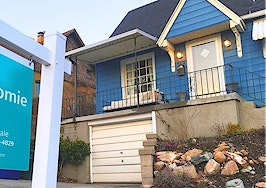“The New Normal” is a multistory Inman series exploring what’s returning to normal after the pandemic fades and what will never be the same. Check back tomorrow for a new installment and join us June 15-17 when we take the conversation live at Inman Connect.
Pre-pandemic ways of doing business have largely fallen by the wayside, and it’s a good thing for the industry as a whole.
Buyers are letting go of what used to be the norm — multiple visits, seeing many homes in person before making an offer, taking their time to decide, asking for a lot of repairs, and leaning on their agents for everything. We’re essentially retraining buyers on how the process works but much more efficiently.
Better technology, fewer showings and open houses, more qualified and prepared buyers all lend to a quicker, less demanding transaction, which means agents could potentially do more business in less time.
In the new normal, transactions will continue to move fast with buyers doing most of the legwork in house hunting, resulting in less back-and-forth and faster decision-making.
Limited showings
During the pandemic, homes were shown mainly for a limited day or time due to safety reasons. When new listings come on the market, there might only be one or two days at most for prospective buyers can see them before offers are due.
Sellers are looking to minimize disruption and create urgency by having a limited showing window and deadline in which offers need to be received.
This method is yielding multiple offers in a short period, which allows the sellers the ability to select the offer that is best for their situation.
This short timespan means buyers have only one shot at seeing it, whether virtually or in person. Appointment times may be limited as well. The buyers may only have a 15-30 minute showing window.
Limited showing times are quickly becoming the norm and not the exception.
No more going back with the tape measure as the buyers or their agents will need to use the measuring app on their phone during the 15 minutes allotted for their showing.
Quicker decisions
In pre-pandemic times, the burden was on the buyer’s agents to ensure they were preapproved for a mortgage loan and verify their proof of funds.
But during the pandemic, all of that changed. Due to health and safety concerns, listing agents required documentation to ensure the buyer was genuinely qualified and a “real buyer” just to set the showing appointment.
Technology has enabled agents to quickly assemble an offer using electronic signature programs and document management and organization software.
Electronic signatures allow buyers to sign offer forms and return them to their agent within minutes. In today’s ultra-competitive market, minutes matter as agents are on a very short deadline to submit an offer. The ability to accept an offer and finalize a binding contract quickly also contributes to the brisk marketing times mentioned above.
And only three obstacles stand in our way when it comes to national digital transactions.
Less back-and-forth
If a buyer is interested in pursuing new construction, builders typically sell lots ahead of developing the land due to construction delays. And they are limited in the number of lots they can sell each month.
Builders have spent a lot of time upgrading their websites so buyers can access robust information about a community online and can look at interactive site maps to see what lots are truly available and which have sold.
Accomplishing this legwork ahead of time will allow the buyer to be ready to go when the builder contacts them with an opportunity to lock into a homesite.
Builders producing this information on the front end reduces a lot of back-and-forth communications on things that buyers can easily reference online. Gone are the days of buyers wandering into a sales model hoping to buy a new home whenever they want.
And if buyers are relocating from afar, the only option is to conduct a virtual meeting whereby the builder can screen share site maps, floorplans and go through various design options to walk the customer through an idea of finishes and pricing.
More demand, less nitpicking
Low inventory, coupled with the speed of putting a transaction together, is fueling as-is home sales. Buyer demand is simply too high for sellers to entertain the home inspection repair lists they used to get hit with before the pandemic.
Buyers are increasingly writing offers with no intention of asking for any repairs unless something of a significant or structural nature comes up.
Post-close extras
Fast marketing times are translating into sellers needing more time to pack up, vacate and secure another place to live beyond the closing date.
Buyers are increasingly granting sellers the ability to stay in their homes past closing, often at no cost for a predetermined length of time.
In fact, the ability of a buyer to offer post-closing occupancy at favorable terms for a seller can often make or break a deal for some sellers.
Elective relocations
With many buyers getting the green light to continue working remotely and some leaving the workforce to retire or pursue other interests, elective relocations are fueling a high volume of moves across the country.
Given the fast pace of many real estate markets, timing a visit to coincide with available houses to see is next to impossible. Enter virtual showings as a solution.
After quickly becoming the new normal last year, virtual showings show no signs of slowing down.
With various video calling methods, agents can simply connect with their buyers on video or capture properties and neighborhoods on their cell phones to send back to their buyers, no matter where they might be.
Buyers no longer have to stress about rearranging their life to travel to see a home that probably will be sold by the time they arrive.
Virtual showings allow agents to quickly jump into action the minute a potential fit for their buyers comes on the market, increasing their buyers’ chances of successfully locking up a winning bid.
Tasking from afar
Technology has not only made buying a home virtually possible, but it has also made it much easier to figure our just about everything else about the home that way.
Many MLSs have linked up with floorplan creator applications that allow agents to create home floorplans right from their phones. The power of Google Earth and street view can help accomplish a lot when a buyer is looking from afar.
Many vendors, such as roofing companies, can quickly provide a quote on a roof based on aerial images and basic information available about the home online.
The ability to share video and photos with various contractors and tradespeople can help facilitate estimates on repairs and improvement work to give buyers and sellers a general idea of costs to expect.
Time-saving client meetings
Just talking on the phone to a buyer or seller seems so 2019ish now, and thanks to a variety of virtual meeting platforms, such as Microsoft Teams and Zoom, to name a few, technology brings us to wherever the clients might be.
Virtual meetings have been a great way to get face-to-face and build rapport, even though the buyers or sellers may be thousands of miles away.
Video meetings allow agents to conduct buyer consultations or listing presentations by tapping into the power of their programs on their laptops.
No longer do you have to hand out MLS sheets to review as comps with a seller when you can present interactively and go through each property online with photos and videos while providing insight as to how it was priced or why it sold.
Switching to a video call with the buyers on their phone has allowed agents to conduct virtual walkthroughs much more efficiently when needed — no more trying to coordinate in-person meetings taking into account travel time and all else.
Now granted, the ability to meet virtually does not necessarily replace in-person meetings, but it does present another avenue in our time-challenged and multitasking society as life gets back in full swing.
As life readjusts to a new normal, the real estate market and way of transacting business have accelerated in ways that may never go back to pre-pandemic times, especially when it comes to buying homes and how buyers see the real estate transaction.
Although face-to-face business will still take place, it’s not the only option, and the speed at which transactions are happening might make a lot of the traditional activities of the past obsolete.
Cara Ameer is a broker associate and global luxury agent with Coldwell Banker Vanguard Realty in Ponte Vedra Beach, Florida. You can follow her on Facebook or Twitter.













